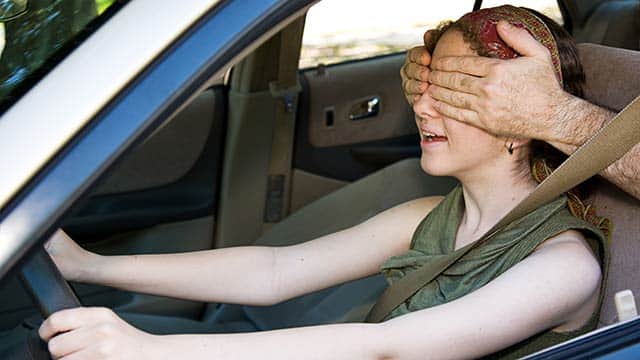At first glance (no pun intended!) the question seems absurd, but as is the case with most situations in life, this inquiry is far more nuanced than you might suppose.
Obviously, good eyesight is essential to safe driving, but every state in the U.S. establishes its own standard with respect to “normal” vision acuity. While these expectations can vary, usually, to pass a vision test for a standard driver’s license a person must possess at least 20/40 vision when both eyes are tested together.
However, close scrutiny of this rule reveals a couple of loopholes.
For example, what if a person isolates the vision acuity of their eyes separately? Additionally, what types of licenses might be available other than “standard”?
Making Sense of the Numbers
First, let’s try to interpret the testing measurements for a person’s vision.
Often, when we use the term “blind” we imagine an individual who cannot see anything—a person who lives with a condition known as no light perception. However, according to the American Foundation for the Blind, only 10-15% of all people with diagnosed eye disorders are completely blind. As a result, multiple classifications of blindness exist to help us better understand what a person can or cannot see.
These categories are quantified based on scores associated with the Snellen eye chart—a document most of us are well-acquainted with. The Snellen chart is situated 20 feet away from a person who then covers one eye and attempts to read the symbols. If you can read the digits on the eighth line, you are considered to have 20/20 or perfect vision.
When the second number is higher, sometimes considerably, we can grasp how different a person’s vision is from the standard. For example, someone with 20/50 vision must be at 20 feet to see what a person with perfect vision sees from 50 feet away.
With all of this information as backdrop, the World Health Organization defines visual impairment as
- Moderate—20/70-20/160
- Severe—20/200-20/400
- Profound—20/500-20/1000
Blind Driving
Now that we understand how these scores work, we can better comprehend the standards that have been set for drivers while keeping in mind that other aspects such as monocular/binocular perspicacity, peripheral acuity, and one’s ability to recognize colors, shapes, or objects within the telescopic field are also examined.
Considering the above groupings and their correlated numbers, it would appear that even a person with a “moderate” visual impairment could be disqualified from driving based on the standard visual expectations of most states: 20/40.
Remember, though, these legalities have some flexibility, and not all states are aligned with their expectations:
- A person can use visionary aid to meet the state’s minimum requirement
- A person can have passable vision in one eye while having worse vision in the other
- A person can receive a restricted driver’s permit
Additionally, most states offer a process by which someone who cannot meet the vision standards can still obtain a driver’s license. This procedure usually entails the acquisition of detailed reports from an optometrist or an ophthalmologist, regularly scheduled reexaminations or updates, additional driver training, a more rigorous road test, and permit limitations.
Daylight Driving
The most common allowance for people with significant vision challenges acknowledges the advantages of daytime driving.
Without going into the details of optometry, the human eye accepts, bends, and passes light much like a camera does and is reliant upon this process to function well. Most of the issues that low-vision individuals encounter—regardless of the disease or injury that hinders their eyesight—are related to their eyes’ shortcomings when it comes to processing light rays. So, while a lack of adequate light can inhibit one’s vision; alternatively, an adequate amount of light can make that same person’s vision passable.
This can be true even for some individuals whose vision scores qualify them as legally blind.
Additional Aids for Blind Person Driving
While a substantial amount of light is the best way to alleviate vision problems, advancements in technology are making safe driving more possible not just for the standard driver but also for drivers with poor eyesight.
The latest measures car manufacturers have introduced include cameras and optical laser systems that promote autonomous driving features. Vehicles now offer options that
- Detect lane departure
- Automatically pivot headlamps
- Warn the driver of objects near or around the car
- Monitor distance between objects
- Regulate speed based on other cars nearby
Even those who cannot afford these latest versions of vahicles with “self-driving” features have options for visual enhancements such as
- Bioptic or telescopic glasses
- Head Up Display (HUD) technology to show instrument panel (dashboard) information in brighter colors, larger numbers, and with warning signals
- Panoramic review mirrors
- Wireless backup camera
Beyond these intuitive gadgets, many low vision drivers have learned to accommodate their disability via astute and routinized habits (as demonstrated in this video) such as taking the same, often wider and safer, roads for their travel patterns, using roadside markers to determine distance and speed, and implementing core safe-driving principles into their daily commute.
The fact is, according to the National Law Review, most accidents are not related to drivers with a vision impairment. Rather, inattentiveness, distractions (eating, texting), fatigue, speeding, and over-confidence are far more dangerous problems for drivers and for those with whom they share the road.
Ultimately, the answer to the question about whether blind people can drive is complex and nuanced.
What we do know for sure is that it isn’t immediately, “No.”


Leave a Reply